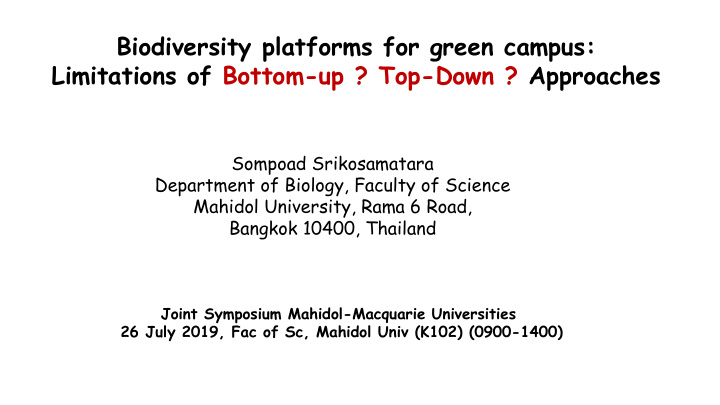



Biodiversity platforms for green campus: Limitations of Bottom-up ? Top-Down ? Approaches Sompoad Srikosamatara Department of Biology, Faculty of Science Mahidol University, Rama 6 Road, Bangkok 10400, Thailand Joint Symposium Mahidol-Macquarie Universities 26 July 2019, Fac of Sc, Mahidol Univ (K102) (0900-1400)
Extended from Urban Biodiversity, Education & New Ecologists Joint Symposium on “ Frontier Research in Biodiversity and Agricultural Resources ” 6-7 Nov 2014, Fac of Sc, Mahidol Univ + Explore Roles of Campus Biodiversity to transformative Education Through bottom-up & Top-down Approaches in 2015-2019
Increasing in urbanized population over rural population is obvious Alberti 2008, 6
Urban Sprawl is obvious in Greater Bangkok Area Bangkok > 200 years (2014 = Ratanakosin Era 233) Science 307: 1718 (18 March 2005)
MUSC = microcosm of Bangkok urbanization phenomena MUSC Phayathai From wetland, Rice field, Slums, garbage dumping ground To modernized university to one obvious green spot in the city Van Beek 1999, 126 Total area = 6.5 ha (40 rai), 24 % green + 10 % lawn
From slums, garbage dumping ground to modern university in 1968 คณะวิทยาศาสตร์ จากถนนพระรามที่ 6 ( ประทัดทอง ) ( ปี 2511) จากสลัม ที่ทิ้งขยะ เป็นคณะวิทยาศาสตร์
To obvious green spot area of Bangkok
MU Salaya Campus has become urbanization later with the impact of urban sprawl 1983 = a small village ชุมชนศาลายากับพื้นที่รอบนอก สถาบันวิจัยประชากรและสังคม 2526 จ าลองพื้นที่สังคมเมือง & ปริมณฑล
Mahidol Salaya 2002 2010 2013 20% 40% 40% 60% 60% 80% Wetland decline Impervious or constructed zone increase Wetland Infrastructure=impervious Total area = 200 ha Big green area = 22.4 ha (140 rai)
Use wetland & city urbanization & sprawl for education & research in ecology: Ecology class 2009
MU Green Epic at Salaya (Top-Down) Urbanized Salaya Big green area closed for 5+ years (5+ years of Mahidol students Lacking experiences on nature) New green areas are very artificial. Still below SDGs target Of “Nature needs half” Size 22.4 ha (140 Rai) Total Universiy area = 200 ha (1240 rai) Accessible again since early 2017
E-co-vo-tho Racing 26 Nov 2014 (Y1) Initiation of using Campus biodiversity for science education for 1 st year students in all majors : outdoor experiences of Bio101 Total students = 266, not access to the large green spaces (opened 2 y later) Use 50 organisms list that students in a group of 20+ had to compete to finish among 10 groups of students = experiential learning ? Transformative learning ?
Racing game: Intragroup Cooperation, Intergroup competition Rank Intragroup Cooperation: 3, (1,9), (4,7), (6,8), 5, 2, 10 ???? Y1: 2014 No of species found Total students: 266 from 27 students/group 50 sp list High inter-group competition drives High intra-group cooperation (Group) Class management = High Total Number of species found in each group from 50 assigned species
Experiential learning from outdoor in Y1: 2014 Link between species & contents: Ecology: 40 % Ethology: 27 % Evolution: 12 %
TOP 12 organisms interested by students Y1: 2014
Activities for subsequent years 2014: E-co-vo-tho Racing (already presented) 2015: Similar outdoor activities like 2014 but 60 species pool 2016: Multiple scale of organisms & environment Meet the President 2017: Tangled bank approach in different habitats 2018: Similar to 2016
2017
2018 Class management = low (Student-centered ?) Total students attended = 57 (Total = 271 of original 328)
2018
Top 10 Rank species found 26 Nov 2018
Distribution of number of species found by each student in 2018 Number Of students Number of species found by each student
Observations Link between species & contents: 2014 2018 Ecology: 40 % 22 % Ethology: 27 % 43 % Evolution: 12 % 35 %
Educational values of Campus biodiversity Species found in 2014 are more than 2018 2014 top species = butterflies; 2018 top species = water monitor 2014 experience guide to ecology 2018 experience guide to ethology (interact with human) Campus biodiversity have been declining & supply less experiences of nature to students
Meet the President From relaxing tour of nature for the President but get more administrators Salaya Educational Ecology + Former Chairman of the University Council Of Mahidol University 31 Jan 2017
Salaya Educational Ecology : Lineated barbet found in Salaya 31 Jan 2017
Lineated Barbet Found in mature or old garden (trees become bigger suitable to be excavated for nesting holes) Found more in 37 years old Campus at Salaya
Top-Down: Too much emphasize On low carbon
Mahidol & 24 institutes aim to be sustainable universities Not just Carbon But should be “Half nature” SDGs: “Nature needs half” 13 Feb 2018
Conclusion University = more & more urbanized Less & less nature (biodiversity) exist in a university Less & less nature experiences students can obtain Education activities to increase students’ experiences on nature (bottom-up but limitation) Campus biodiversity decline = less educational ecology on nature (= limitations of top-down ?) Green University still emphasize on low carbon New SDGs (Sustainable Development Goals) since 2015 request “half nature” Mahidol university requires more biodiversity to fulfil “half nature” according to SDGs (a new goal)
Questions are welcome
Recommend
More recommend